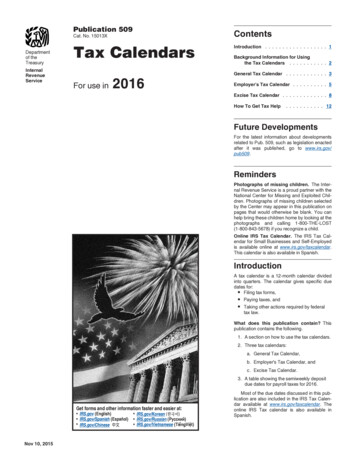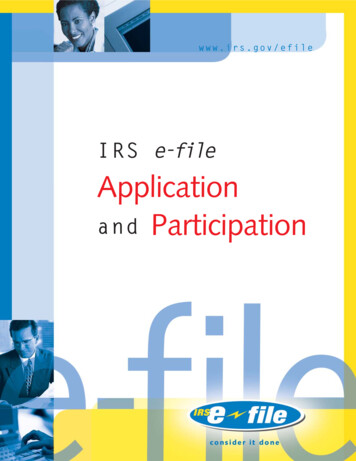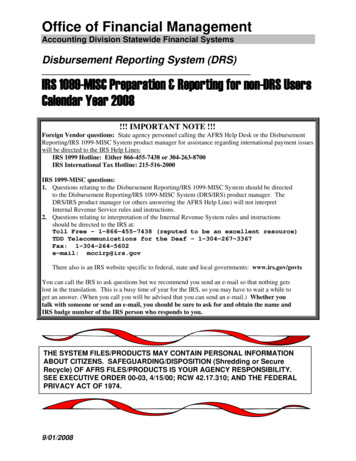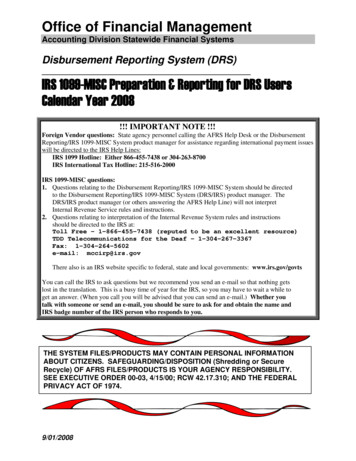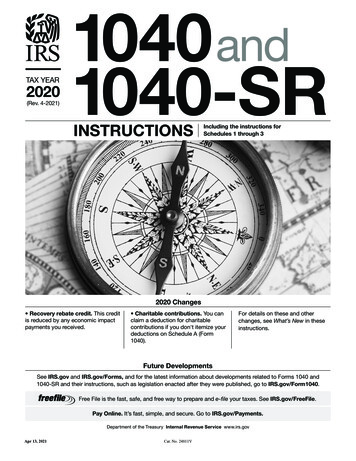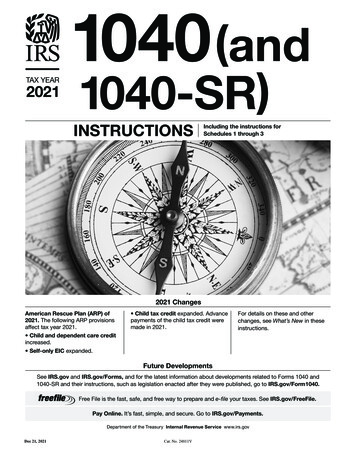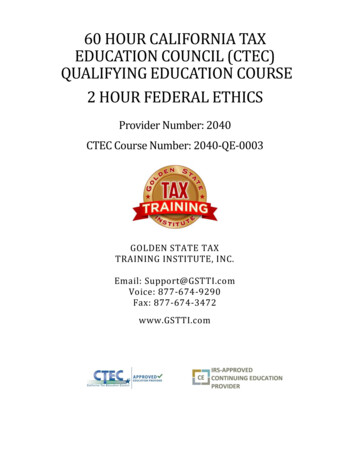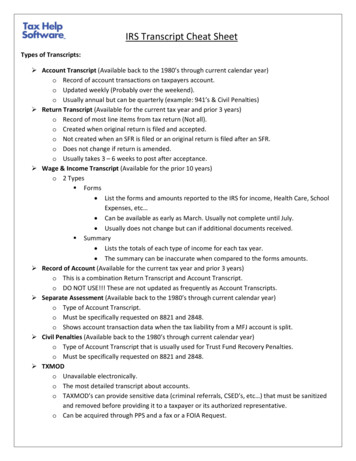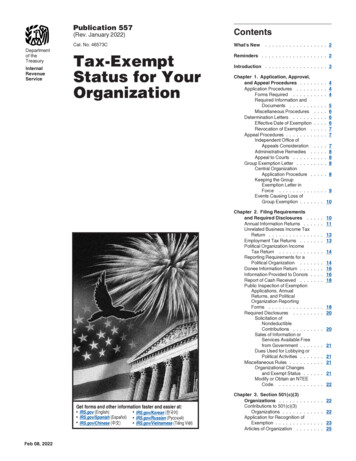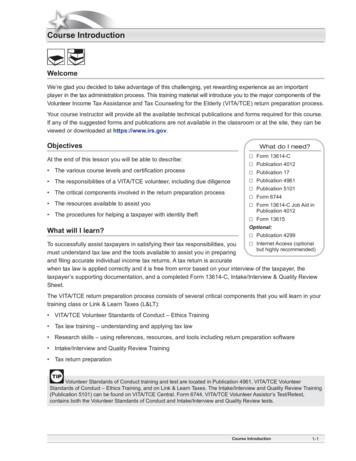
Transcription
Course Introduction WelcomeWe’re glad you decided to take advantage of this challenging, yet rewarding experience as an importantplayer in the tax administration process. This training material will introduce you to the major components of theVolunteer Income Tax Assistance and Tax Counseling for the Elderly (VITA/TCE) return preparation process.Your course instructor will provide all the available technical publications and forms required for this course.If any of the suggested forms and publications are not available in the classroom or at the site, they can beviewed or downloaded at https://www.irs.gov.ObjectivesAt the end of this lesson you will be able to describe: The various course levels and certification process The responsibilities of a VITA/TCE volunteer, including due diligence The critical components involved in the return preparation process The resources available to assist you The procedures for helping a taxpayer with identity theftWhat will I learn?What do I need? Form 13614-C Form 13615Publication 4012Publication 17Publication 4961Publication 5101Form 6744Form 13614-C Job Aid inPublication 4012Optional: Publication 4299Internet Access (optionalTo successfully assist taxpayers in satisfying their tax responsibilities, youbut highly recommended)must understand tax law and the tools available to assist you in preparingand filing accurate individual income tax returns. A tax return is accuratewhen tax law is applied correctly and it is free from error based on your interview of the taxpayer, thetaxpayer’s supporting documentation, and a completed Form 13614-C, Intake/Interview & Quality ReviewSheet.The VITA/TCE return preparation process consists of several critical components that you will learn in yourtraining class or Link & Learn Taxes (L<): VITA/TCE Volunteer Standards of Conduct – Ethics Training Tax law training – understanding and applying tax law Research skills – using references, resources, and tools including return preparation software Intake/Interview and Quality Review Training Tax return preparationVolunteer Standards of Conduct training and test are located in Publication 4961, VITA/TCE VolunteerStandards of Conduct – Ethics Training, and on Link & Learn Taxes. The Intake/Interview and Quality Review Training(Publication 5101) can be found on VITA/TCE Central. Form 6744, VITA/TCE Volunteer Assistor’s Test/Retest,contains both the Volunteer Standards of Conduct and Intake/Interview and Quality Review tests.Course Introduction1-1
Unlike most classes, there is no need to memorize a lot of information. You can use information from irs.gov,your course materials, and other print and electronic sources to gain the knowledge and insights you needto serve the taxpayers you assist.At the completion of your course of study, you will fully understand how to apply critical aspects of eachcomponent of the process and complete an accurate return for each taxpayer you assist.Thank you for your interest in helping the IRS achieve its mission of providing America’s taxpayers withtop quality service by helping them understand their tax responsibilities and by applying the tax law withintegrity and fairness to all.Let’s get started!How is the course structured?Due to the production schedule for this training guide, draft forms may be used in illustrations. The draft formsshould never be used for actual tax preparation. Final forms are available on https://www.irs.gov, in the tax preparation software, in the instruction booklet (e.g., Form 1040 Instructions), or in other publications.There are two tax law certification paths and two optional specialty courses presented in this publication,each representing a level of certification. The first six lessons apply to all levels of certification. Beginningwith the Income lessons, the course levels for the subject being covered will be indicated by the followingicons:Basic covers the completion of wage earner type returns.Advanced covers the completion of the full scope of VITA/TCE returns.Military covers topics applicable to members of the Armed Forces, Reserve, and National Guard.I nternational covers topics applicable to military and non-military taxpayers living outside the UnitedStates.Volunteers wishing to certify in Military or International must follow the Advanced certification path andshould also review the applicable specialty course.Foreign Student and Scholar and Puerto Rico certifications are separate specialty courses available onL<.At the beginning of each lesson, icons are displayed after the lesson title. If a section of a lesson isassociated with only one certification level, the corresponding icon is displayed at the beginning of thatsection. If no icons are displayed in a section, all icons displayed after the lesson title apply.What is the training approach?Each course uses the process-based training (PBT) approach. PBT is a structured fact-gathering processthat combines tax software and tax law training to help you prepare an accurate return. To complete theprocess, you will use: Form 13614-C, Intake/Interview & Quality Review Sheet, to interview the taxpayer for filing status,dependency, income, credits, deductions, validate the information provided, and prepare the return. Reference materials, such as Publication 4012, Volunteer Resource Guide; Publication 17, Your FederalIncome Tax for Individuals; and tax software help features, as well as other resources available at your1-2Course Introduction
site, to prepare the return. These materials will assist you with standardized questions to ask taxpayersduring your interview, to help you prepare a 100% accurate tax return. Volunteer Resource Guide, Tab K – Quality Review Process, to conduct a quality review of all returns.Adhering to a quality review process helps ensure accurate returns are prepared at all VITA/TCE sites.In most cases, when you have completed the return, it will be filed electronically. There should only be rareinstances when the taxpayer may need to mail the tax return to the IRS.What do I need to get started?In addition to this publication, VITA/TCE training materials include the following items: Publication 4012, Volunteer Resource Guide Form 6744, Volunteer Assistor’s Test/Retest Publication 4961, VITA/TCE Volunteer Standards of Conduct – Ethics Training Publication 5101, Intake/Interview & Quality Review TrainingWhat other resources are available to help me learn?Finalized blank forms can be accessed at https://www.irs.gov/forms-instructions.You may use the Practice Lab integrated with the online course, L<, to complete exercises, practicereturns, and test scenarios using the tax software.What happens after I complete this course?After completing this course, you will have an understanding of tax law and the guidelines and tools neededto prepare an accurate return. After you certify, and complete and sign Form 13615, Volunteer Standards ofConduct Agreement, you will be prepared to volunteer at a VITA/TCE site.How does this certification work?To participate in the VITA/TCE programs, all volunteers must pass the Volunteer Standards of Conductcertification test. In addition, all tax preparers, Quality Reviewers, instructors, and Site Coordinators mustpass the Intake/Interview and Quality Review test. To prepare tax returns in the VITA/TCE programs, youmust then pass at least the Basic certification test. Alternatively, you may certify at the Advanced level.You are not required to certify in Basic before taking the Advanced test. A minimum score of 80% isrequired to pass any certification test. You may take online tests that are available in Link & Learn Taxes onhttps://www.irs.gov. Online testing is fast and efficient; you will know immediately if you passed, and canobtain Form 13615 for your Site Coordinator. Volunteers who do not pass the test the first time may reviewthe course material and try again. A paper test option (Form 6744) may also be available. Talk with yourinstructor or Site Coordinator for more information on these options.You must pass the Volunteer Standards of Conduct and Intake/Interview and Quality Review tests prior toaccessing the Basic or Advanced certification test.All designated reviewers and peer-to-peer reviewers are required to have Basic or higher certification basedon the complexity of the return. It is strongly encouraged for volunteers to certify at the Advanced level.SPEC encourages the Quality Reviewers to be the most experienced volunteers in tax law application.Volunteer instructors must certify at Advanced and an applicable specialty course, depending on the taxtopics instructed.Course Introduction1-3
If a volunteer does not achieve the minimum required score on the test or the retest, the volunteeris encouraged to participate in the program in another capacity such as greeter, client facilitator,communication specialist, or technical support.When you achieve the certification(s) and present your signed Volunteer Standards of Conduct Agreement,your Site Coordinator or instructor may provide you with a VITA/TCE programs Volunteer ID Insert. Theinsert was created to acknowledge the accomplishment of certified volunteers, as well as to assist internaland external stakeholders in identifying certified volunteers, but is not intended to be used as proof ofcertification. You should bring your Volunteer Standards of Conduct Agreement, Volunteer ID Insert (if youhave one), and photo ID to the tax preparation site.What types of returns can I prepare?It is important that you assist only with returns, supporting schedules, and forms for which you have beentrained and certified. You are protected by the federal Volunteer Protection Act of 1997 as long as you areonly preparing returns within the scope of the VITA/TCE programs. Refer taxpayers with tax situationsoutside your scope of training and certification to your Site Coordinator and/or a professional tax returnpreparer. The training resources and tools discussed in this guide support the completion of a basic Form1040 and associated tax forms. A complete list of what is within the scope of the VITA/TCE programs canbe found in the front of the Volunteer Resource Guide. Do not prepare returns that fall outside the scopeof the VITA/TCE programs. Applicable lessons list some out of scope tax law topics for the VITA/TCEprograms.Am I legally liable for returns I prepare?VITA/TCE program volunteers are not considered paid preparers; therefore, you are not legally liableunder federal law for the return you prepare. This means you cannot accept payment of any kind fromthe taxpayer for preparing a federal tax return or for providing any other tax-related assistance. You areprotected by the federal Volunteer Protection Act of 1997, as long as all of the following conditions are true: You are acting within the scope of your volunteer responsibilities. You completed the level of training and certification required for preparing tax returns at your site. The harm was not caused by willful, criminal, reckless, grossly negligent, or conscious, flagrantlyindifferent acts.How does the IRS identify volunteer-prepared returns?Each return should be identified with the appropriate site identification number (SIDN) to ensure it is readilyidentifiable by the IRS. Your site’s SIDN is an 8-digit number preceded by the letter “S” that must appearin the Paid Preparer Use Only section on all returns you prepare, both paper and electronic. Your SiteCoordinator provides this number along with other necessary guidelines for completing the return.Identity Protection PIN (IP PIN) ProgramNationwide, identity theft continues to grow at an alarming rate. The IRS developed a strategy to addressthe problem of identity theft-related tax administration issues. The IRS strategy continues to evolve, but isfocused on three priorities that are fundamental to addressing this challenge: victim assistance, outreach,and prevention. Victim assistance: The IRS is working to speed up case resolution and provide more training foremployees who assist victims of identity theft.1-4Course Introduction
Outreach: The IRS is educating taxpayers so they can prevent and resolve tax-related identity theftissues quickly. Prevention: The IRS is implementing new processes for handling returns, new filters to detect fraud, newinitiatives to partner with stakeholders, and a continued commitment to investigate the criminals whoperpetrate these crimes.Refer to the IRS Identity Theft Central page at https://www.irs.gov/identity-theft-central to stay currenton IRS efforts to combat this growing problem. A wide range of information on identity theft is presented,ranging from how to contact the IRS with a case of identity theft to tips for keeping taxpayer records safe.How to assist taxpayers who may be victims of identity theft at VITA/TCE sitesBeing sensitive towards victims of identity theft is critical to assisting taxpayers through a confusing andfrustrating situation. Remember victims of identity theft are: Victimized by identity thieves – mostly through no fault of their own and Trying to comply with tax laws – file tax returns and pay their fair share of taxesEvery December, the IRS mails Notice CP01A to taxpayers previously identified as identity theft victims.The notice includes a 6-digit Identity Protection Personal Identification Number (IP PIN) to be entered onthe tax return. Taxpayers are mailed Notice CP01A every year as long as the identity theft indicator remainson their account (usually 3 years). Use the most recent IP PIN regardless of the tax year.Use the following table when assisting taxpayers who are victims or may be victims of identity theft at aVITA/TCE site.If.Then.Identity Protection PIN (IP)PIN was issued to primary/secondary taxpayer anddependent.Ensure the IP PIN is input correctly on the tax return.Taxpayer received an IPPIN but did not bring it.1. Complete a paper tax return for the taxpayer.2. Provide taxpayer with a complete copy of the tax return. (Provide twocopies if the taxpayer will mail the tax return.)3. Refer to the Lost, Misplaced, or Non-Receipt of IP PIN information below.4. If taxpayer wants to e-file, arrange for the taxpayer to provide the IP PINby returning to the site or via telephone.If.Then.Taxpayer received an IP1. Complete a tax return for the taxpayer.PIN but misplaced or lost it. 2. P rovide taxpayer with a complete copy of the tax return. (Provide twocopies if the taxpayer will mail the tax return.)3. Refer to the Lost, Misplaced, or Non-Receipt of IP PIN information below.4. If the taxpayer receives an original or a reissued IP PIN and wants toe-file, arrange for the taxpayer to provide the IP PIN by returning to thesite or via telephone.Course Introduction1-5
If.Then.Taxpayer did not receivean IP PIN, but IRS rejectedthe e-filed tax returnbecause the IP PIN wasnot entered.1. Refer to the Lost, Misplaced, or Non-Receipt of IP PIN information below.2. Provide taxpayer with two complete copies of the tax return.3. If the taxpayer receives the original or a reissued IP PIN and wants toe-file, advise the taxpayer to provide the IP PIN by returning to the site orvia telephone.4. If the IRS does not provide the IP PIN, advise taxpayer to follow IRSinstructions in mailing the tax return. There may be processing delays asIRS verifies the taxpayer’s identity.IRS rejected the taxpayer’stax return because thetaxpayer’s primary/secondary and dependentSSN was previously used.1. Advise the taxpayer to contact the IRS for assistance. If required, the IRSwill advise the taxpayer to complete Form 14039 and to mail it with theirtax return to the IRS. Taxpayers can use the Federal Trade Commission(FTC) web portal to file IRS Form 14039, Identity Theft Affidavit, onlineand the IRS will respond with a letter about 30 days after it has receivedall necessary information. See https://www.identitytheft.gov/.2. Provide the taxpayer with two copies of the tax return.Lost, Misplaced, or Non-Receipt of IP PINIf a taxpayer did not receive a new IP PIN or the taxpayer misplaced it, the taxpayer has two options:1. Register and create a user profile to get a current IP PIN. The registration process will require thetaxpayer to provide specific personal information and answer a series of questions to validate his/heridentity. Use key words “IP PIN” in the search window at irs.gov to access the Retrieve Your IdentityProtection PIN (IP PIN) application.2. Contact the IRS at 1-800-908-4490 to request the IP PIN be reissued by mail if the taxpayer is unable orunwilling to create an account on irs.gov.If the reissued IP PIN letter is not received within 21 days after contacting the IRS or the taxpayer cannot meetthe requirements for a reissued IP PIN, filing by paper is the taxpayer’s only option.Identity Protection PIN on Form 1040 ReturnsForm 1040 includes a series of six boxes just to the right of the taxpayer’s and spouse’s occupation (page 2).These boxes are clearly marked as “Identity Protection PIN.” Refer to the Volunteer Resource Guide, Tab P,Partner Resources, or go to irs.gov to view Form 1040.If taxpayers choose to file the return on paper, the letter issued by the IRS will instruct them to write thesix-digit IP PIN in the area just to the right of the taxpayer’s and/or spouse’s occupation.For the IP PIN to be accepted, all six digits must be input on Form 1040. The IP PIN may begin with a zero.Effect of the IP PIN on Tax AdministrationThe IP PIN acts as an identity validation tool only. The IP PIN indicates that taxpayers previously providedIRS with information that validates their identity and that IRS is satisfied that the taxpayers are the validowners of the SSNs.1-6Course Introduction
Returns that are filed on accounts with an IP PIN indicator present are processed as valid returns usingstandard processing procedures.Returns that are filed on accounts with an IP PIN indicator present that do not have an IP PIN, or the IP PINwas not input correctly, will experience delays while IRS validates the identity of the taxpayer against IRSrecords.What are my responsibilities as a VITA/TCE programs volunteer?As a VITA/TCE programs volunteer, you have a responsibility to provide quality service and to uphold theethical standards of the program. When you begin as a volunteer, you will be asked to sign the VolunteerStandards of Conduct Agreement, which states that you will adhere to these standards: Follow the Quality Site Requirements (QSR) Not accept payment, solicit donations, or accept refund payments for federal or state tax returnpreparation from taxpayers Never solicit business from taxpayers you assist or use the knowledge gained about a taxpayer for anydirect or indirect personal benefit Never knowingly prepare false returns Never engage in criminal, infamous, dishonest, notoriously disgraceful conduct, or any other conductdeemed to have a negative effect on the IRS Treat all taxpayers in a professional, courteous, and respectful mannerAs a volunteer, follow these standards for return preparation: become certified, use the intake/interview andquality review process, use reference materials, complete the steps to electronically file tax returns, andadhere to the privacy and confidentiality guidelines.What is due diligence?Due diligence means doing your part to ensure tax returns are correct. As an IRS-certified volunteer, youensure the information on the return you are preparing or reviewing is correct and complete.Doing your part includes: Confirming a taxpayer’s (and spouse if applicable) identity Providing top-quality service by helping taxpayers understand and meet their tax responsibilities Making sure the facts presented by the taxpayer paint a reasonable pictureGenerally, you can rely on good faith for taxpayer information without requiring documentation asverification. However, exercise caution when taxpayers want to claim a refundable credit such as EIC oreducation credits, especially if these credits are maximized.Top 4 Things to Remember about Due Diligence1. Do your part to ensure a tax return is correct.2. Question any unusual, inconsistent, or incomplete items.3. If you are unsure about a deduction or credit, make an effort to research the answer, or ask anothercertified volunteer for assistance.4. Remind taxpayers that when they sign their tax returns, they are stating under penalty of perjury that thereturn is accurate to the best of their knowledge.Course Introduction1-7
The following examples illustrate unusual or questionable situations that call for more information from thetaxpayer.exampleLarry goes to a VITA/TCE site to have his taxes prepared. Larry tells the tax preparer: His filing status is Head of Household He wants to claim his 2-year-old nephew for EIC He has no child care expenses He earned 19,000 in wages He is 26 years oldLarry’s information regarding his qualifying child and filing status is questionable. Further inquiries areneeded to determine: Why the uncle is claiming the child and not the parents? Why isn’t there child care expense and who cares for the child while the taxpayer works? Is there anyone else living in the household that contributes? Is there anyone else eligible to claim the child? Do the tie-breaker rules apply? If asked, can the taxpayer provide proof that the qualifying child lived with him for more than half of theyear?exampleSteven goes to a VITA/TCE site to have his taxes prepared. Steven tells the tax preparer: He is 22 years old He has two sons, ages 10 and 11 He has Social Security cards for both boys and himself His W-2 wage indicates earnings of 20,000Steven’s age and the age of the qualifying children appear to be inconsistent. Further inquiries areneeded to determine: Are the boys his sons by birth, foster sons, adopted sons, step-sons? Is there anyone else eligible to claim the children as qualifying children? Do the tie-breaker rules apply? If asked, can the taxpayer provide proof that the qualifying children lived with him for more than half ofthe year?As a certified volunteer, remember due diligence and take reasonable steps to ensure the tax return iscorrect: Ask enough questions to determine if allowable expenses were incurred and that income reported iscorrect. Add all taxable income to the tax return. If the item is questionable and/or unallowable, do not claim the deduction or credit on the tax return.Make a note on the Intake/Interview & Quality Review Sheet to alert the reviewer. If you are uncomfortable with the information and/or documentation provided by a taxpayer, do notprepare the tax return. If the taxpayer does not agree with your advice, you should not prepare the return.1-8Course Introduction
Tax return integrity means volunteers must take reasonable steps to ensure the tax return is correct, whichincludes: Verifying that all Social Security numbers presented by the taxpayer match the Social Security numberslisted on the tax return. Not preparing out of scope returns. Not preparing returns for which you have not been certified. Explaining to the taxpayer what income is taxable, and why a deduction or credit can or cannot beincluded on their return. Use IRS reference materials to support your statements. Having a second certified volunteer quality review the completed return and discuss it with the taxpayer. Not making changes or corrections to the tax return after the taxpayer leaves the site without notifyingthe taxpayer.In conclusion, as an IRS-certified volunteer preparer, you have the responsibility to perform adequate duediligence on EVERY return. The goal is not to prepare as many tax returns as possible, but to accuratelyreport taxpayer income and deductions.How do I maintain the taxpayer’s trust?You are the key to the integrity of the VITA/TCE programs. Taxpayers will trust that all information youreceive from them is protected from disclosure. To maintain this trust: Do not disclose any personal tax information gained as a result of the service provided. Do not openly discuss taxpayers by name in the presence of other volunteers or taxpayers. You maydiscuss tax situations with other volunteers. For example, a volunteer may refer to a situation (not ataxpayer) and ask or give advice about the appropriate tax treatment for that specific situation. Do not retain taxpayers’ documents for a follow-up visit. If you cannot fully complete the taxpayer’s returnat the time of service, return all documents to the taxpayer. Do not take taxpayers’ information for preparation of the return outside the presence of the taxpayer,unless Virtual VITA/TCE procedures are being used. Do not prepare a tax return when you suspect an individual is not providing truthful information. Do not exclude any of the taxpayer’s relevant income or expenses, regardless of whether they increaseor decrease the amount of tax due or refund.Having the taxpayer present in the tax preparer’s site is not always possible. In these cases, Virtual VITA/TCE processes can be used to prepare returns without taxpayer face-to-face contact. Certified volunteersmay interview taxpayers over the phone while preparing their return. The alternative process used toprepare returns must be approved by the responsible IRS Territory Manager prior to the start of the filingseason to ensure all procedures are in place as described in the QSR. Most importantly, the taxpayer’s andgovernment’s interests must be properly protected. In some cases, the taxpayer information must be leftat the site to be prepared and mailed to the taxpayer. Adequate security and privacy is expected to ensuretaxpayer records are properly safeguarded.Some individuals may attempt to defraud the government by filing false tax returns. If you have anyquestion about the validity of information provided by a taxpayer, or are uncomfortable with a taxpayersituation, discuss your concern with your Site Coordinator.If you or a taxpayer have a concern or issue regarding unethical behavior at a site, e-mail WI.Voltax@irs.gov. Also, see Publication 730, Important Tax Records Envelope (VITA/TCE), Publication 4454, YourCivil Rights Are Protected, or Publication 4053, Your Civil Rights Are Protected Poster for IRS AssistedPrograms, for reporting Civil Rights (Title VI) and EEO concerns.Course Introduction1-9
Taxpayer Civil RightsThe Department of the Treasury – Internal Revenue Service will not tolerate discrimination based on race,color, national origin (including limited English proficiency), disability, reprisal, sex (in education programs oractivities) or age in programs or activities receiving federal financial assistance from the Internal RevenueService.If a taxpayer believes that he or she has been discriminated against, a written complaint should be sent to:Operations Director, Civil Rights UnitInternal Revenue Service, Room 24131111 Constitution Avenue, NWWashington, DC 20224For all questions about taxpayer civil rights, contact us at the above address, or by e-mail atedi.civil.rights.division@irs.govDo not send tax returns, payments, or other non-civil rights information to this address.Low Income Taxpayer ClinicsLow Income Taxpayer Clinics (LITCs) are independent from the IRS. LITCs serve individuals whose incomeis below a certain level and need to resolve tax problems with the IRS, such as audits, appeals, and taxcollection disputes. In addition, clinics can provide information about taxpayer rights and responsibilities indifferent languages for individuals who speak English as a second language. Services are offered for free ora small fee.For more information or to find a clinic near you, see the LITC page athttps://www.taxpayeradvocate.irs.gov/about/litc or IRS Publication 4134, Low Income Taxpayer ClinicList. This publication is available online at https://irs.gov or by calling the IRS at 1-800-829-3676.What is the Taxpayer Advocate Service?The Taxpayer Advocate Service (TAS) is an independent organization within the IRS that helps taxpayersand protects taxpayer rights. Its job is to ensure every taxpayer is treated fairly and that taxpayers know andunderstand their rights under the Taxpayer Bill of Rights.TAS offers free help to taxpayers in resolving tax problems they haven’t been able to resolve on their own.If the taxpayer qualifies for TAS assistance, the taxpayer will be assigned to one advocate who will workthrough the process and do everything possible to resolve the issues. TAS can help if: The problem is causing financial difficulty for the taxpayer’s family or business Taxpayer or taxpayer’s business is facing an immediate threat of adverse action Taxpayer has tried repeatedly to contact the IRS, but no one has responded, or the IRS has notresponded by the date promisedTAS has at least one taxpayer advocate office located in every state, the District of Columbia, and PuertoRico. The local advocate’s number is in the local directory and at https://taxpayeradvocate.irs.gov/, orcan be reached at 1-877-777-4778.What is the Taxpayer Bill of Rights?The Taxpayer Bill of Rights describes ten basic rights that all taxpayers have when dealing with the IRS.The Tax Toolkit at https://taxpayeradvocate.irs.gov/ can help taxpayers understand what these rightsmean and how they apply.1-10Course Introduction
How else does the Taxpayer Advocate Service help taxpayers?TAS works to resolve large-scale problems that affect many taxpayers. If you know of one of these broadissues, please report it at https://www.irs.gov/sams.Are there other materials available to assist me?When you arrive at the tax preparation site, your Site Coordinator will assist you with your resourceneeds. Your site may even have a technical research library from which you can access various forms,publications, and worksheets. These materials can also be downloaded from https://www.irs.gov.You should not use this g
Form 6744, VITA/TCE Volunteer Assistor's Test/Retest, contains both the Volunteer Standards of Conduct and Intake/Interview and Quality Review tests. What do I need? Form 13614-C Publication 4012 Publication 17 Publication 4961 Publication 5101 Form 6744 Form 13614-C Job Aid in Publication 4012 Form 13615. Optional: Publication 4299
